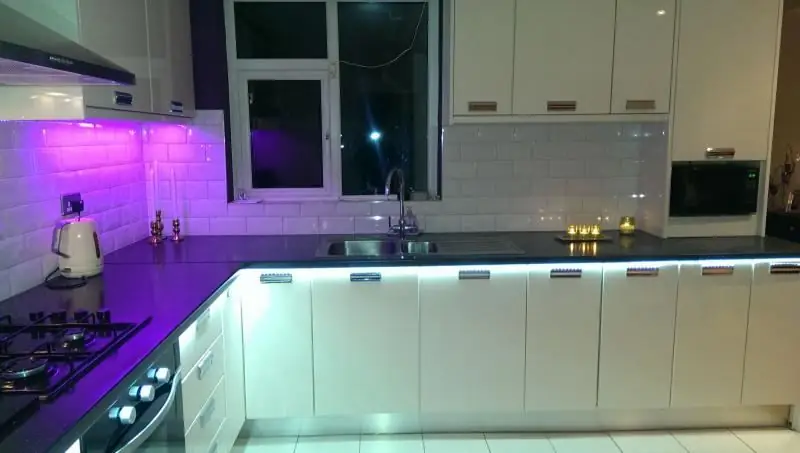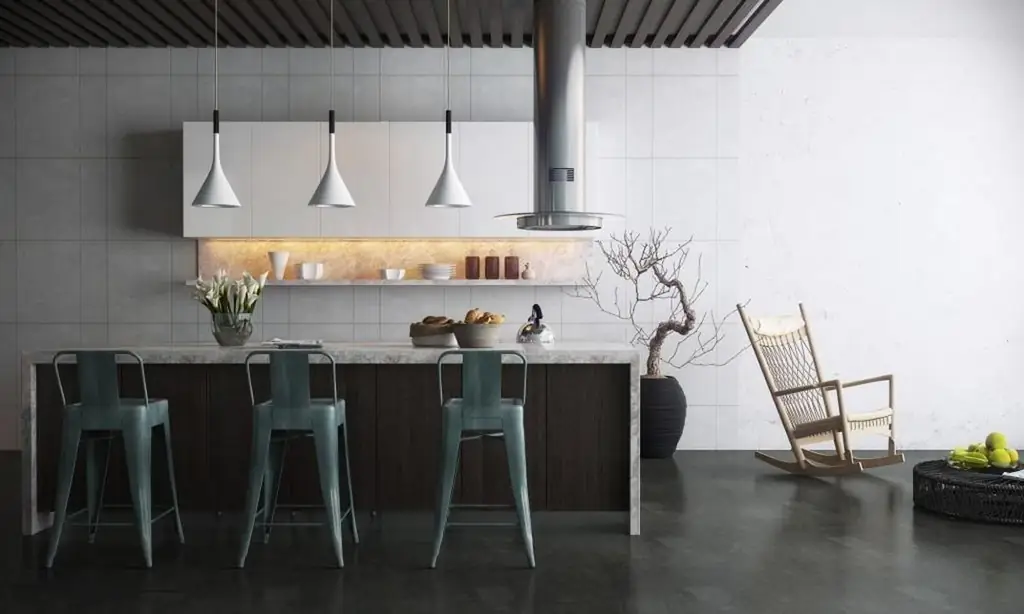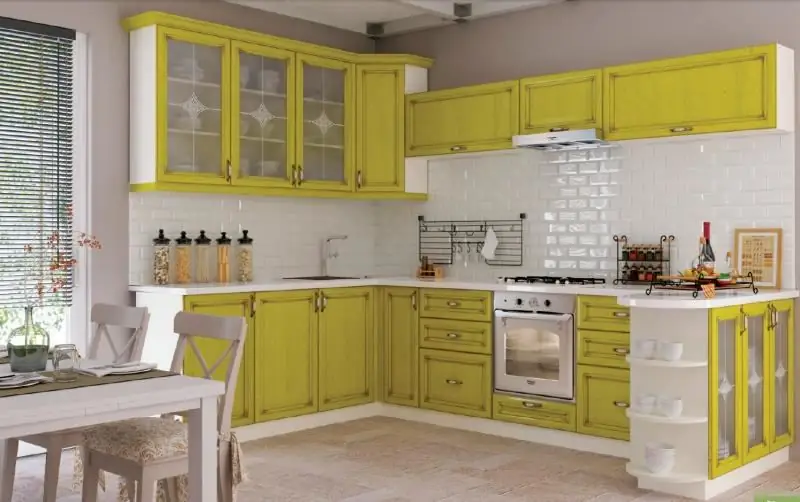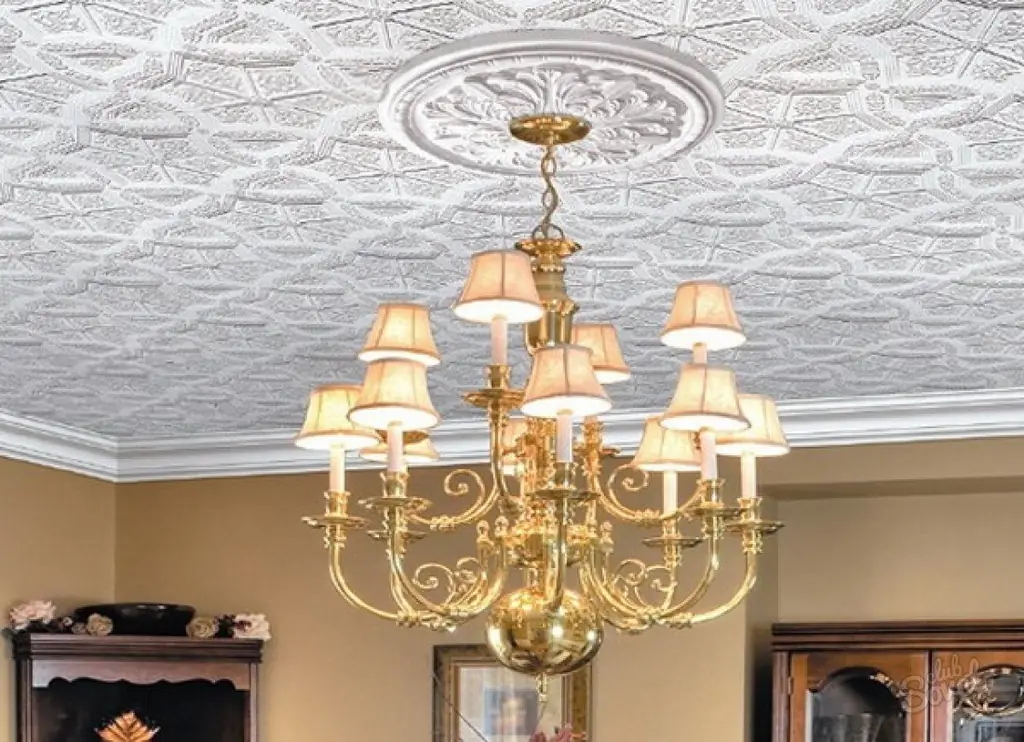
Table of contents:
- Author Bailey Albertson [email protected].
- Public 2024-01-17 22:26.
- Last modified 2025-01-23 12:41.
How to make your kitchen light, stylish and comfortable: choosing a ceiling lamp

Choosing a lighting fixture for a kitchen ceiling is not as easy as it seems at first glance, because the right lighting should make the room for receiving and preparing food not only as comfortable as possible, but also safe. Modern industry offers many types of lighting fixtures, when choosing from which you need to take into account the characteristics of a particular kitchen, its size, and interior design.
Content
-
1 Types of ceiling lamps for the kitchen
- 1.1 Chandeliers
- 1.2 Spotlights
-
1.3 Pendant lights
1.3.1 Photo Gallery: Pendant Light Models
- 1.4 Spot systems for the kitchen
-
2 Selection and arrangement of lamps depending on the size of the kitchen and the type of ceiling
- 2.1 Video: how to properly place lamps in the kitchen
- 2.2 Installation tips
-
2.3 Color and material as selection criteria
2.3.1 Photo gallery: ceiling lighting in modern and classic kitchen interiors
Types of ceiling lamps for the kitchen
When you need to illuminate the kitchen well, and the natural flow of light is not enough, you have to use various types of artificial lighting. Of the lighting fixtures installed on the ceiling, there are three most common types:
- chandeliers;
- Spotlights;
- suspended.

Several types of lamps can be used for good lighting in the kitchen.
Chandeliers
The chandelier is the most classic of the ceiling lamps, but despite this, its use does not lose its relevance in the interiors of fashionable styles. It will look most impressive in a spacious kitchen, if you need to additionally illuminate the dining table, and the high ceiling will allow you not to reduce the useful space, even for a hanging structure. But even for small kitchens, you can choose your own type of chandeliers, because now designers offer flat ceiling shades that will look especially good on stretch ceilings.

A chandelier with a bright lampshade immediately attracts attention
By design, chandeliers are divided into:
-
Suspended. They consist of one or several shades of different sizes and shapes, fixed on a cord, chain or string. Lampshades can be made of various materials: plastic, wood, glass, fabric.

Hanging chandeliers If one chandelier cannot illuminate a large kitchen, you can use several shades or combine them with spot lighting
-
Ceiling. Well suited for rooms with low ceilings. Such lamps usually consist of a single flat shade of a simple geometric shape made of transparent or frosted glass or plastic. But sometimes options are used with a large number of shades of complex shapes and colors. The disadvantage of such lamps is that to replace the light bulb, you will have to completely remove the cover.

Types of ceiling chandeliers Typically, ceiling chandeliers are characterized by a classic geometric shape, but there are also bold design options.
In accordance with the design of the kitchen, the style of the chandelier itself is also selected:
-
Classic. They have a twisted metal forged frame with crystal pendants and stones. Usually they consist of several horns. They can be complemented with glass or fabric cylindrical lampshades. Often there are models that simulate lamps with chains. Used in classic and neoclassical interiors, country, Italian style, luxury.

Classic chandelier Classic crystal chandeliers are used in different styles of interiors, but they are not suitable for a small room
-
Modern. Such chandeliers are universal, they are distinguished by shades of smooth shapes without edges and sharp corners and dull shades (usually a combination of white and metallic). Although they look simple, they can provide a general style of design. Due to their versatility, they are combined with various interiors - from classic to loft or hi-tech, minimalism, chalet, Scandinavian style, Art Deco.

Art nouveau chandelier Art Nouveau ceiling lamps feature soft, smoothly curved shapes
-
Chandelier. Chandeliers that mimic antique candlesticks were traditionally made from crystal, but cheaper glass or plastic options are now available. Such models are used in the interiors of shabby chic, modern, chalet, classic, provence, rustic.

Chandelier A chandelier that imitates an old candelabrum will perfectly fit into the style of Provence or chalet
-
Technostyle or hi-tech. Luminaires of these styles are more often ceiling-mounted than suspended. They are distinguished by simple geometric shapes, strict edges, laconic colors. Plafonds made of the most durable and high quality materials - metal, glass, plastic, stainless steel.

High-tech ceiling chandelier Extravagant ceiling chandeliers with chrome shades look spectacular in the high-tech kitchen
-
Floristic - shades made in the form of interweaving of flowers, branches, leaves. They are varieties of classic chandeliers. The frame is made of metal or wood, shades - glass, crystal, ceramic, fabric, metal. The range of colors is close to natural combinations. Various models will fit into a classic style kitchen, modern, chalet, provence, country and even high-tech.

Floral chandelier A floral chandelier will decorate the kitchen, but the interior should also be matched
-
Eco-style. In lamps of this style, wood should be present, even if in small quantities, as a frame or lampshade. The light is welcomed warm, reminiscent of the sun. Plafonds are necessarily made of natural materials, most often wood; they also use paper and fabric. Wicker structures made of bamboo or rattan look spectacular; stones, branches, dried flowers can be used for decoration. You can make a lampshade yourself. It will fit not only in eco-cuisine, but also in country style, ethno, Provence, techno.

Eco-style chandelier You can make an eco-style lampshade with your own hands from natural materials
-
Minimalism. It is characterized by a simple harmonious design of strict geometry, without decor. Shades of plafonds are unsaturated, usually white, black, gray, beige. Prints are not allowed. Natural materials are used for lampshades - wood, stone, frosted glass, fabric. Plastic is also allowed, but it should look high-quality and exclusive. The light is soft and diffused, without glare. The design can be either suspended or overhead. They correspond to loft, high-tech, Scandinavian, minimalist style finishes.

Minimalist chandelier Minimalistic chandelier fits perfectly into the interior
-
Loft. Lamps of this style mimic rough industrial or street lights. They should give maximum light, therefore they are quite large. The frames are made of various pipes, tires, cords, flexible parts that imitate plumbing elements to give the interior an industrial and unfinished look. The tree is not used in this case. Bare lamps without shades are characteristic. Depending on the model, in addition to the loft style, they can fit into the interiors of country, minimalism, modern, retro, boho.

Loft style chandelier A rough lamp of an unusual shape will fit well into a loft-style kitchen
-
Crystal. A subtype of classic chandeliers decorated with crystal pendants. This increases the strength of the illumination and creates an unusual light refraction effect.

Crystal chandeliers Crystal pendants create an interesting effect by refracting light
-
Tiffany. Graceful shades of colored glass, glass mosaic or decorated with stained glass painting. Suitable for classic interior design, tiffany, country, boho chic, art deco.

Tiffany style chandeliers Mosaic effect will decorate any room
Spotlights
This type of luminaire is most often used in conjunction with suspended or suspended ceilings. Typically, spot lighting is considered local, combined with chandeliers, but you can use it as the main one. This will be especially appropriate in a small kitchen.

Spot lighting helps to visually expand the space due to the absence of shadows
The main advantage of spotlights, or spotlights, is a uniform diffused stream of light and the absence of shadows, which are inevitable when using a single ceiling lamp. In addition, they provide a good opportunity to zone a room when they are turned on in separate groups, using different models or lamps of different colors. Saving energy using halogen and LED lamps will also be an undeniable advantage.
The casing of the soffits is fireproof and moisture resistant. There are models with the arrangement of lamps inside and outside the plafond, which allows you to create directional or diffused light. One point is designed for lighting no more than 2 m 2 of the room.
The disadvantages of spot lighting are more complex installation and the need to build in fixtures immediately at the stage of installing the ceiling (ceiling) or assembling furniture (local).

Spotlights come in various models and are not always invisible
By the method of installation, soffits are divided into:
-
recessed - they are used only with suspended or suspended ceilings, they can be completely embedded in the base or protrude above the surface;

Recessed spotlight Embedded (cut-in) models are the most popular
-
overhead - suitable for a regular concrete ceiling;

Spot light fixture Spot spotlights have fasteners suitable for any type of ceiling
- suspended.
By the type of lamps used, the lamps are divided into:
-
LED. Such structures practically do not heat up, which allows their use with a finish that contains flammable materials. The most economical in terms of energy consumption are recessed LED ceiling lights. They are rotary and non-rotary.

Rotary and non-rotary spotlights Swivel light allows you to change the direction of light
- Halogen. Such lamps have the greatest durability, but also an increased cost. They also get very hot, so the lamp should consist of a ceramic cartridge and a metal frame. In addition, the installation of a transformer will be required.
- With incandescent lamps. They are distinguished by bright light, but are short-lived and consume a large amount of electricity.
Pendant lights
This type often replaces a chandelier when illuminating a dining table or worktop. They are not used to illuminate the entire kitchen space, since they do not provide enough light. They are a group of luminaires suspended from the ceiling or attached to one panel. Such models look good in a large modern kitchen. The length of the suspension can be adjusted. Shades can be located at the same height or represent a multi-level structure.

A group of pendant lights will not be able to illuminate the entire kitchen, but they are very effective as local lighting.
For groups of several lamps, models with strict, laconic shades of the same size are chosen. The color of the shade is selected in accordance with the main decoration of the room. Bright shades will look harmonious in light interiors, but they should be used as an accent, without overloading with details.
The lampshade can be made from various materials. Most often, glass is used, due to its good light transmission characteristics, resistance to high temperatures, and easy cleaning. Modern models can be made of plastic, the advantage of which is an affordable price, lightness and strength. In designer interiors, for example, in the oriental or Provence style, shades of paper or fabric are used, but they rather perform a decorative function, as they are prone to inflammation and quickly become dirty.
Photo gallery: models of pendant lamps
-

Group of six pendant lights - Hanging lamps of strict colors and shapes are used in a minimalistic interior.
-

Pendant lights above the dining table - With the help of pendant lights, you can select a work or dining area
-

Country style pendant lamp - The original solution is a luminaire of several lamps enclosed in one body
-

Pendant lights in a classic interior - Elegant glass shades never go out of style
-

Pendant lights above the work area - Pendant lights are usually used in conjunction with other types of lighting
-

Asymmetric pendant lights - The color of the shades matches the finish of the kitchen, and the asymmetrical shape gives an accent
-

Spotlights on a common suspension - Pendant panel with spotlights looks unusual and stylish
-

Lamps with pink shades - Pink shades create an unobtrusive color accent
-

Art Nouveau pendant lamps - For an Art Nouveau interior, discreet pendant lamps are well suited
Spot systems for the kitchen
In translation from English "spot" means "spot". These lamps received this name for the ability to highlight any area with a bright spot using a directed beam of light. This is a convenient, reliable and functional type of ceiling lamps, which are produced in different variations, have attachments both to the ceiling and to the walls, and allow the use of various lamps.

Combining multiple spot systems allows for adequate lighting in the kitchen
A distinctive feature of the spots is the presence of swivel arms, which allow directing the light to a certain point. The advantages of spot systems are:
- ease of installation and the ability to install anywhere on the ceiling;
- saving space in comparison with chandeliers with better lighting quality;
- affordable construction cost;
- energy savings due to the ability to use a spot system instead of several types of lamps;
- a variety of design models, allowing you to choose a lamp for any interior style.

Swivel spots direct the light to the right place
The spots differ in the shape of the bracket, which can be straight, curved, volumetric or flat, in the number and type of lamps, and in the method of attachment. The most common spot consists of one lamp, but for more convenient illumination of several objects at once, systems consisting of two or three, or even six or eight lamps are used.
By the method of attachment there are:
- classic, where the luminaire is mounted on a mounting plate with a cover masking the mount;
- recessed - installed on a suspended or suspended ceiling, they need sufficient space for fixing and wiring;
- with a bar mount - the disadvantage of this design is hanging wires, but it can cover a larger space and looks spectacular in modern interiors, for example, in the loft style.

The bar can be lowered or raised
By type of lamps:
- Incandescent lamps easily tolerate high humidity and temperature changes, in contrast to energy-saving ones. But they get very hot, so they are not suitable for plastic shades without a reflective surface, as well as for use near stretch plastic ceilings. In addition, these lamps do not have a variety of light spectrum.
- Halogen bulbs are durable but cannot withstand sudden changes in temperature. Have the brightest light that is closest to daylight.
- LED - do not need a deflector, easily withstand a large on-off cycle.
We installed spots not only in the kitchen, but also in the bedroom. I love the fact that they are good at saving space, unlike hanging chandeliers, which are often inappropriate in small modern apartments. The husband is satisfied with the lighting from the ceiling spot, even directed at the desk. For me, this kind of lighting is not enough, in addition, there are still shadows, so I have to complement it with local ones.
Selection and arrangement of lamps depending on the size of the kitchen and the type of ceiling
The kitchen more than other rooms needs space zoning. This is especially true when combining a kitchen with a living room, when various types of lighting can be the only way to divide the room. In addition, lighting a specific area helps save energy and time by not having to go back to the main switch every time.
Depending on the ceiling:
- With a conventional painted or whitewashed concrete ceiling, modern built-in systems will not work. Therefore, the choice will have to be stopped on a traditional chandelier or lighting panels, supplementing with wall lamps if necessary.
- The plasterboard ceiling forms a small distance to the overlap, which allows the installation of surface-mounted or recessed lamps.
- Stretch ceiling makes it possible to use almost any type of lighting fixture, but its disadvantage is that it can melt from incandescent or halogen lamps.
- The rack ceiling allows you to place any luminaire with all kinds of lamps.
- The wooden ceiling is effectively accentuated by forged chandeliers or built-in spotlights.

Spotlights accentuate a beautiful wooden ceiling without cluttering it
Zoned lighting is necessary even for a small kitchen in order to highlight functional spaces - working and intended for eating. In a room of spacious dimensions, it is enough to hang a chandelier above the table, which will immediately indicate the dining area, and in a small area, a bulky hanging structure will have to be placed in the center of the entire room, and the cutting area will have to be supplemented with LED spotlights.

In a spacious kitchen, a chandelier above the table allows you to highlight the dining area
Pendant lights are positioned exactly above the dining table. In this case, the size of the shades is related to their number (the more shades, the smaller they should be) and to the size of the room. Soffits well separate the dining area from the cutting room, this is especially true in small kitchens. The number of lamps should provide good lighting. Swivel lamps will be appropriate in the working area so that it is convenient to direct the light stream to the desired point.
In a room with a limited area, flat structures will help to visually raise low ceilings - ceiling chandeliers, lighting panels, built-in spots or spotlights, and overhead oval or rectangular lamps will help to visually expand the space. On high ceilings, volumetric chandeliers, suspended structures, and roof rails will be relevant. In a spacious kitchen, it is easy to combine flat and pendant lights.
If point lighting is used as the main one, light points are placed at least 30-40 cm apart from one another. The gaps between soffits and corners must be at least 20 cm.
It is recommended to install points according to the principle: one point for 1.5 m 2 or a 20 W luminaire for each 1 m 2 of the ceiling. If the power of the luminaires will exceed 20 W or they will be combined with other types of lighting, their number can be reduced. You can visually increase the usable area of a narrow or elongated kitchen by installing a group of several lamps along the central line of the ceiling and on both sides of it.
With a sufficient ceiling height, it can be decorated with a multi-level, which zones the space well. A similar solution is relevant for a studio apartment or if the kitchen and living room are combined.

Multilevel ceiling lighting zones the space well
Principles for placing lighting fixtures at different levels:
- the backlight is placed on the side surfaces of the second or third level;
- spot lighting is placed around the perimeter, on a flat surface of the second level, in the ceiling niches;
- pendant lights are best placed above the dining area. They are mounted only on the first level of a multi-level ceiling;
- the lighting panels are installed flush with the main ceiling or on a base surface.
Video: how to properly place lamps in the kitchen
Installation tips
It is quite possible to install ceiling lamps of suspended and surface-mounted type on your own:
- The hanging chandelier only needs to be hung on a special ceiling hook, after having connected it to the wiring.
- Surface-mounted luminaires are screwed to the ceiling with a drill and dowels.
- With built-in lights, everything is more complicated. They are installed by the same specialists who install the ceiling. For lighting, places are pre-designed and wires are pulled, then, when installing the ceiling, holes are cut and power is connected to the lamps themselves.
Color and material as a selection criterion
The use of warm or cold light spectrum depends on the interior style. It should be noted that a warm spectrum enhances the sharpness of colors, while a cold one can distort shades. For example, blue will become gleaming green, and red will take on a dirty tint. Therefore, when choosing a cold spectrum of lamps, the colors of the decoration and furniture should be selected especially carefully.
Most often, lamps of standard colors are selected for the kitchen: the metal case is gold or silver, white is quite common. The case can be either glossy or matte - here you can experiment in every possible way according to your tastes. Shades are made in any color scheme. The main rule is that they do not get out of the general design. For example, if a kitchen decorated in monochrome looks boring, you can add a chandelier in a rich, bright color. This will act as a bright accent that attracts attention and immediately revives the interior.

Pendant lights bring white kitchens to life with vibrant colors and unusual shapes
Traditional glass or metal shades are appropriate for any interior style. But unusual design details are allowed. For example, a wicker lamp shade will present the owner of the kitchen as a creative and creative person. A varied hand-made is also encouraged. Everything here is limited only by your imagination.
Photo gallery: ceiling lighting in modern and classic kitchen interiors
-

Country style kitchen - In country style, chandeliers are appropriate that imitate candelabra with candles, Tiffany chandeliers, lamps like lanterns and lampshades
-

Loft style kitchen - The loft style is characterized by high ceilings; spots are often used as lamps
-

Scandinavian style kitchen - In the Scandinavian style, numerous spotlights, floor lamps, sconces, separate illumination of the working and dining areas are welcome
-

Classic style kitchen - In classic interiors, chandeliers are often used that imitate a lamp with candles.
-

Eco-style kitchen - In an eco-style, minimalistic simple lamps are used - pendants with lamps without shades, pendants, sconces or chandeliers with glass, cork, paper, bamboo or rattan lampshades
-

Provence style kitchen - In the Provencal style, lighting should be diffused and soft, so many small fixtures are added to the main light source
-

High-tech kitchen - High-tech kitchen lamps can be easily distinguished by their unusual shape, “space” design and materials - glass and metal
-

Minimalist kitchen - For a minimalistic kitchen, lamps should also be selected as functional and discreet as possible.
-

Boho style kitchen - A chandelier with multi-colored pendants will complement the boho-style interior
The outdated opinion that the whole room can be illuminated with one device is especially irrelevant for the kitchen, where a person spends a considerable amount of time. It is not difficult to choose and correctly combine various types of lamps, the main thing is to take into account the rules of placement, the size and style of the interior of the room.
Recommended:
Lighting For The Kitchen Under The Cabinets And Above The Working Area: LED Strip And Surface-mounted Lamps To Illuminate The Surface Of The Kitchen Set

Types of LED backlighting, their pros and cons. Options for placing the backlight of the kitchen set. Installation of LED strip and expert advice
Ceiling Chandelier In The Kitchen: How To Choose Depending On Style, Photo With Ideas

Features of the choice of a chandelier, taking into account the size and style of the kitchen. Photos of chandeliers in kitchens, made in different styles. Methods for attaching a chandelier to the ceiling
Pendant Lamps For The Kitchen: Selection And Installation Features, Photo

How to choose pendant lamps for the kitchen, their types and features. Recommendations for location and installation. Use cases in modern interiors
Kitchen With Patina On The Kitchen Set And Furniture: What It Is, Interior Design Features, Photo

What is patina. Advantages and disadvantages of patination. Kitchen design with patina: colors, styles and interior features
A Simple Way To Redecorate The Ceiling: How To Properly Glue The Ceiling Tiles, Step-by-step Recommendations + Photos And Videos

Practical advice on ceiling renovation with ceiling tiles. How to choose the right tile, glue. Tile installation methods
